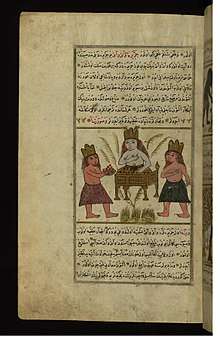al-Wakwak
Al-Wakwak (Arabic: ٱلْوَاق وَاق al-Wāq Wāq), also spelled al-Waq Waq, Wak al-Wak or just Wak Wak, is the name of an island, or possibly more than one island, in medieval Arabic geographical and imaginative literature.[1]

And in the Arab versions, in the sea of China there is also the famous island of Waq-Waq as reported by most medieval Arab geographers. This island is ruled by a queen and the population is only female: it is usually illustrated in al-Qazvini manuscripts of the Wonders of Creation showing the queen surrounded by her female attendants.[2]
Ibn Khordadbeh mentions Waqwaq twice: "East of China are the lands of Waqwaq, which are so rich in gold that the inhabitants make the chains for their dogs and the collars for their monkeys of this metal. They manufacture tunics woven with gold. Excellent ebony wood is found there. And again: Gold and ebony are exported from Waqwaq."[3] Michael Jan de Goeje offered an etymology that interpreted it as a rendering of a Cantonese name for Japan. Gabriel Ferrand identified it with Madagascar, Sumatra or Indonesia.[3] Tom Hoogervorst argued that the Malagasy word vahoak, meaning "people, clan, tribe", is derived from the Malay word awak-awak, "people, crew". Ann Kumar agrees with Tom, and identifies wakwak as Indonesia, and implores the possibility of ancient Indonesian attack on Africa's east coast.[4]
Wakwak is referred to in a number of sources; it is generally an island far away.
The waqwaq tree
Tongdian by Du Huan mentions an Arab account of a tree growing little children.
In the Kitab al-Bulhan, the painting titled the ‘Tree of Waq Waq’ is rather extraordinary because it illustrates the way in which the all-female population reproduces and self-perpetuates. Female figures grow from the tree as if they mature like fruit until they are ripened and they drop to the ground emitting a cry that sounds like 'Waq Waq!'[2]
An Andalusi versions mentions beautiful women as the fruit of the tree.[3]
Mauny thinks this may be the pandanus tree, called Bakkuwan by the Bataks of Indonesia and grown in Madagascar where it is called Vakwa.[4]
See also
- Jinmenju, a strange Japanese tree in Toriyama Sekien's Konjaku Hyakki Shūi.
- Nariphon, a tree in Buddhist mythology which bears fruit in the shape of young female creatures.
- Zaqqum, a tree in Jahannam, the fruits of which are shaped like the heads of devils.
References
- G. R. Tibbetts; Shawkat M. Toorawa; G. Ferrand; G.S.P. Freeman-Grenville (22 August 2013). "Wāḳwāḳ". In P. Bearman; Th. Bianquis; C.E. Bosworth; E. van Donzel; W.P. Heinrichs (eds.). Encyclopaedia of Islam (Second ed.). Brill Online.
- The ‘Book of Surprises’ (Kitab al-bulhan) of the Bodleian Library.
- Saudi Aramco World: The Seas of Sindbad, Paul Lunde.
- Kumar, Ann. (1993). 'Dominion Over Palm and Pine: Early Indonesia’s Maritime Reach', in Anthony Reid (ed.), Anthony Reid and the Study of the Southeast Asian Past (Sigapore: Institute of Southeast Asian Studies), 101-122.